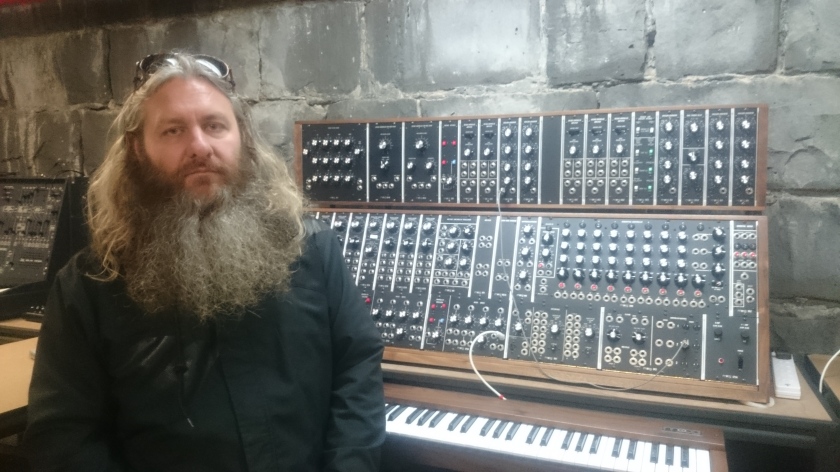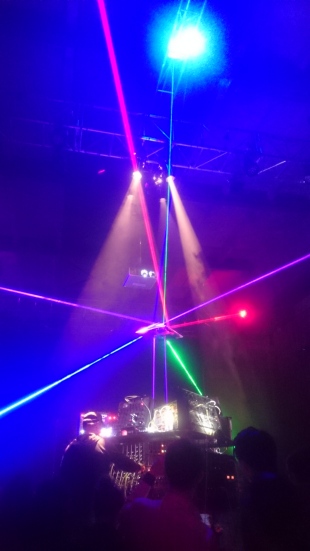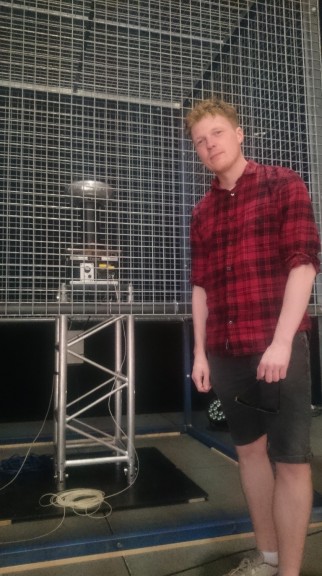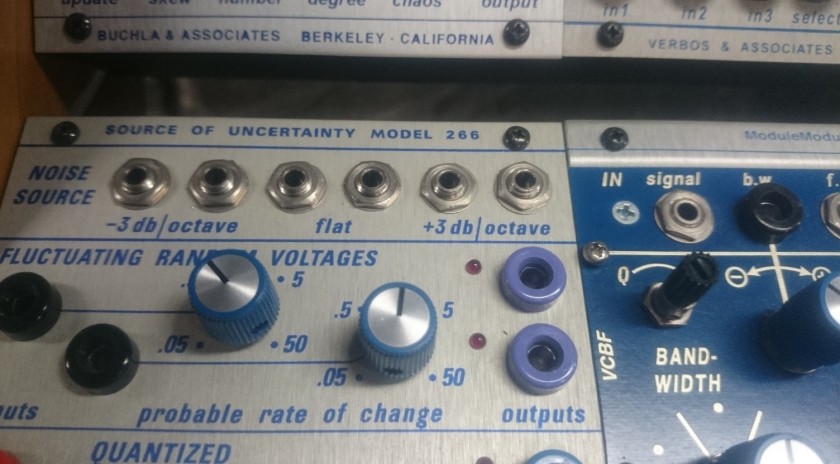Amy Robertson, Monash Journalism
People with pacemakers be warned – this show is not for the faint-hearted.
Hypnotic, futuristic and suspenseful, Robbie Thomson (The Influencing Machine 2016, Pendulum 2016) and the Melbourne Electronic Sound Studio’s event ‘ROBBIE THOMSON: XFRMR/MESS:LIVE’, is a high-voltage show of electronica, light and sound.
Performed at the Substation as part of the Melbourne Festival, Glasgow-based artist Robbie Thomson makes electricity visible with his caged Tesla coil. This bizarre and unlikely instrument produces a dazzling yet ominous display of musical lightning.
This is music you can feel – and it will shake you to your core.
“I remember playing once in Edinburgh and there were a few walk outs. I spoke to people afterwards and they were like ‘it was too intense, we started feeling sick’,” Thomson says.
Experiencing the Tesla coil is like waking up in an 80’s sci-fi horror film – but that moment in the film when you realise you are about to die.
Like Thomson, the directors of MESS have as much energy as they have electronica running through their veins.
Since MESS opened its doors in early April 2016, ‘MESS: LIVE’, produced by directors of MESS, Robin Fox and Byron Scullin, is the first live performance by the organisation.
Colourful laser light-beams bounce off of mirrors, as the audience hover around a towering cube of 25 synthesizers placed in the middle of the room.
Like being on a spaceship about to go into battle, or at a futuristic disco on acid, MESS was loud, eerie and intense.
The synthesizers range from the late 60’s until the present. They include large modular ‘synths’, like the Moog system 55, all the way down to the Triadex Muse, which sits at the top of the synthesizer cube.
Artist, composer and director of MESS, Robin Fox says the inspiration behind the show was to use the incredible machines at MESS and use them in a combination that had never been done before.
“Because we have such a weird collection. We have some particular synthesizers that were built in Melbourne in the late 70’s and only three of them were ever made,” Fox says.

Robin Fox at MESS studio. Photo: Amy Robertson
Synthesizers like the Transaudio Procase 6, which Fox’s step-father helped build in the late 70’s.
“It will be pretty much the first time a lot of these synthesizers have played together.”
As a technical challenge, Fox and Scullin wanted to see if they could synch them all together. They used a universal clock as a tempo, that would lock as many machines together as possible.
You can feel their music in your heart, literally. MESS blur the boundary between music and audience, artist and viewer. Their music becomes a part of you.

‘Synth cube’. MESS at ‘MESS:LIVE’. Photo: Amy Robertson
“We wanted to create a trance like situation – trance the psychological state. The idea was to create a motoric and relentless pulse that would morph over time and sort of locks into your heartrate,” Fox says.
Less than five minutes into MESS’ performance and a man is carried out of the venue, disorientated and confused. Definitely not for the faint-hearted.
Fox says his performances usually have a particular theme or atmosphere, but he never tries to influence an audience’s interpretation or response to a show.
“Some people make incredibly didactic artworks and meaning is at the centre of what they do. What’s much more interesting to me is experiential works,” he says.
Fox likes people to have an experience – “a somatic experience and a visceral experience, because sound is somatic and visceral.”
Like Fox, Thomson’s artwork and his Tesla coil are not intended to convey a message to his audience. It is about the experience and quality of sound, composition and light.
“It’s about exploring the music and the possibilities the tesla coil has as an instrument in its own right,” he says.

Robbie Thomson with his Tesla coil. Photo: Amy Robertson
As an artist, Thomson is interested in kinetic sculpture, music, lighting, design and technology. He started performing with the Tesla coil in 2012. It allows him to combine his interest in science and electromagnetic fields with his longstanding love of electronica.
“I remember getting the bus to school once in high-school and my mate gave me three mini discs – Aphex Twin’s ‘Drukqs’, Squarepusher’s ‘Go Plastic’ and the Prodigy’s ‘Music for the Jilted Generation’ – I listened to those mini discs over and over again. I was hooked on electronic music after that,” he says.
Fox’s love of electronica and his involvement in MESS stems from his family. He inherited an interesting collection of rare and valuable synthesizers from his step-father, which are now available for use at the MESS studio.
While Fox was studying at La Trobe his friend discovered some synthesizers in one of the campus dumpsters, that his step-father built in the 70’s.
He recalls coming home from university to find his mother recording different noises and sounds around the house on various recording devices.
“She used to mic everything up and would be throwing things into buckets of water from a distance, and trying to turn her voice into a bird with electronic stuff. I used to think she was nuts,” he says.
The synthesizers Fox inherited from his step-father were sitting in a studio unused, so he created a space where the public would have access to these rare machines.

Buchla synthesizer at MESS studio. Photo: Amy Robertson
MESS, which is the brainchild of Robin Fox and Byron Scullin, has the best publicly accessible collection of electronic instruments in the world.
The idea behind MESS was to give the general public access to instruments they could no longer afford to buy.
“We realised there wasn’t really anything like this in the world. We wanted members to be able to buy a yearly membership and have incredibly affordable access to an incredible collection of instruments,” Fox says.
Their collection includes both East and West Coast synthesis. East Coast synthesizers were refined, functional and practical. West Coast were radical, experimental, “music of the future”.
“We’re really influenced by some of the people who looked at electronic music as a possibility for redefining music,” he says.
“There’s a real utopianism attached to electronic instruments, there’s a sense that people are trying to create a better future.”
When synthesizers first emerged there was paranoia they were going to completely obliterate the livelihoods of working musicians. Musicians would be irrelevant because music could all be done electronically.
“What happened was much more interesting,” Fox says.
Electronic music became its own form and genre, completely unrelated to the attempt to replicate acoustic instruments.
MESS and Thomson’s passion and understanding of electronic instruments is evident in their performances. This show will make you appreciate the dedication, passion and technical prowess involved in performing electronica live.
‘ROBBIE THOMSON: XFRMR/MESS:LIVE’ is a dizzying, unsettling, yet intoxicatingly beautiful experience. Definitely not one for the faint-hearted.